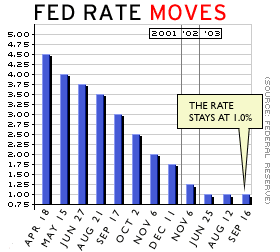NEW YORK (CNN/Money) -
Is the Federal Reserve closer than ever to raising short-term interest rates? It is, if you believe the market reaction to Friday's news that U.S. payrolls grew in September.
But many economists aren't so sure, and some even say Friday's data could keep the Fed on hold even longer.
Non-farm payrolls added 57,000 jobs in September, the Labor Department said Friday, defying analysts' expectations for more job losses and marking the first positive month for payrolls since January. Stocks reacted with a rally, and Treasury bonds sold off, pushing interest rates higher (since rates move opposite to price).

Federal funds futures contracts, which bet on the future direction of Fed policy, have eliminated any chance of a Fed cut at the central bank's next policy meeting, scheduled for Oct. 28, and even priced in a slim chance that the Fed could start raising rates at that meeting.
But it's doubtful Fed Chairman Alan Greenspan and his compadres were popping champagne corks over one piece of data, many Fed-watchers said.
"'Watch for [Fed members'] comments this week; they'll say, 'It's just one month,'" said Anthony Crescenzi, bond market strategist at Miller Tabak & Co. "They tend to look at the cumulative evidence on certain issues before passing any meaningful judgment with policy significance. They need much more than this."
Picking up the slack
The Fed cuts rates to make borrowing cheap and stimulate economic growth. It raises rates to slow the economy down and fight inflation.
In past economic cycles, the Fed started raising rates soon after the recovery began, because inflation was usually fairly high and expected to go higher. In the latest cycle, however, inflation has continued to slow down, despite more than seven straight quarters of economic growth.
| Related stories
|

|
|
|
|
The biggest reasons for this change, according to many economists -- including Fed Governor Ben Bernanke, an influential member of the Fed's policy committee -- is that the economy hasn't generated enough demand to take up all of its "slack." "Slack," in this case, is the nine million or so unemployed people, the millions more who are underemployed, and a small mountain of production equipment sitting idle in U.S. factories.
As long as these people and equipment are underworked and underused, there will be little upward pressure on prices -- inflation could, in fact, continue to slow down in the coming months, according to Bernanke's theory.
"This time, we're starting with an inflation rate that's too low and heading lower," said former Fed Governor Lyle Gramley, now a consulting economist with Schwab Washington Research. "What that means is the Fed will sit still until such time as it sees inflation start turning up -- which might not happen until late 2004 or early 2005."
Some economists pointed out that, underneath the somewhat positive headline of Friday's report, there was a distressing sign of just how much "slack" the economy might really have. The Labor Department unexpectedly cut the benchmark for one of its employment surveys by 145,000 jobs, meaning there were 145,000 fewer people employed as of March 2003 than economists first thought.
"That means there is even more slack in the labor market than we had previously thought, giving the Fed even more reason to sit tight for the next several months," said John Silvia, chief economist at Wachovia Securities, who believes the next Fed rate hike won't come until at least the second quarter of 2004.
Risk in waiting too long
After making 13 cuts since January 2001, the Fed's key interest rate is at a 40-year low. With the economy showing signs of improvement, some economists worry the Fed, which is holding rates low out of fear that inflation will fall, is out of touch with reality.
The danger is that the Fed may realize too late that inflation has more upward momentum than expected, and it will have to raise rates dramatically to stop prices from ballooning out of control. The sudden jump in rates could stomp all over a nascent economic recovery.
"The Fed is clearly not in the mood to preempt inflation," said Paul Kasriel, senior economist at Northern Trust in Chicago. "They're going to wait, and that ultimately will have some unpleasant ramifications."
In a sense, unless the Fed is just bluffing and really isn't that worried about a further fall in inflation, it's really gambling quite a lot on its belief that such disinflation is a risk.
If Treasury markets think the Fed's out of touch and that inflation will skyrocket, they will push long-term interest rates higher in an effort to help yields keep up. If this persists, then continuing Fed inaction will only make matters worse, since it will only increase inflation expectations.
"The Fed needs to align itself with the inflation expectations of the market, unless it has a strong -- and hopefully accurate -- view about how the inflation trend is evolving," said Crescenzi of Miller Tabak.
The evidence of their accuracy -- or lack thereof -- will be revealed in coming months, mainly in data about the labor market and consumer prices. If those show gathering strength, there may be a quick turnaround in Fed policy -- though such a shift might not happen until at least the early months of 2004.
Otherwise, the Fed's cutting campaign might have a little more life.
"With surging productivity keeping alive chances of further disinflation, even another Fed rate cut cannot be ruled out," Citigroup chief economist Robert DiClemente said in a research note.

|

